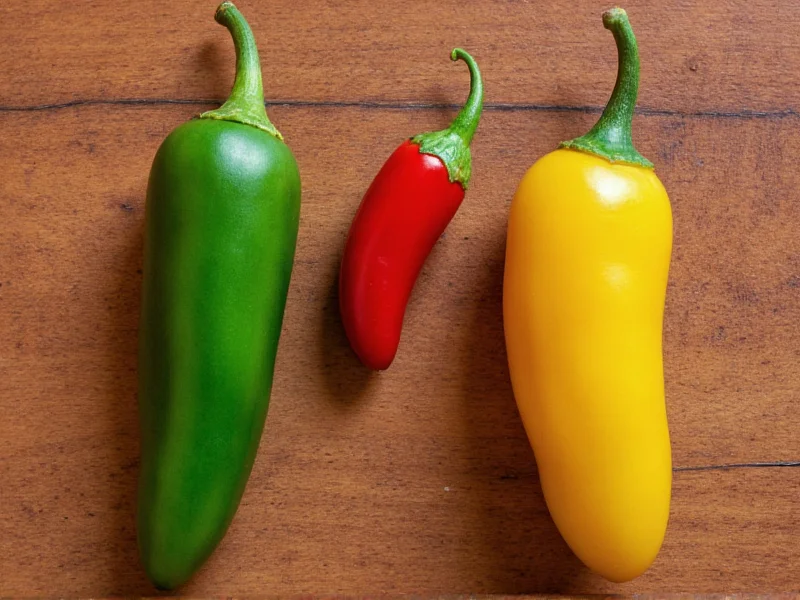When deciding between jalapeño and serrano peppers for your next culinary creation, understanding their heat differences is crucial. Both popular in Mexican cuisine, these peppers serve different purposes in the kitchen based on their distinct heat profiles and flavor characteristics. Let's explore exactly how these two peppers compare in terms of spiciness, appearance, flavor, and culinary applications.
Scoville Scale Comparison: Measuring the Heat Difference
The Scoville scale provides an objective measurement of chili pepper heat. Developed by pharmacist Wilbur Scoville in 1912, this scale measures the concentration of capsaicin—the compound responsible for a pepper's heat—in Scoville Heat Units (SHU).
| Pepper Variety | Scoville Heat Units (SHU) | Relative Heat Comparison |
|---|---|---|
| Jalapeño | 2,500-8,000 | 1-2.5 times hotter than poblano |
| Serrano | 10,000-23,000 | 2-9 times hotter than jalapeño |
| Habanero | 100,000-350,000 | 10-40 times hotter than serrano |
This substantial difference means that substituting one for the other without adjustment can dramatically alter a dish's heat profile. A recipe calling for two jalapeños might become uncomfortably spicy if you use two serranos instead.
Physical Characteristics and Flavor Profiles
Beyond heat levels, these peppers differ in appearance and flavor nuances that affect their culinary applications:
- Jalapeños: Typically 2-3 inches long, with smooth, dark green skin that turns red as they mature. They have a grassy, bright flavor with moderate heat that builds gradually
- Serranos: Smaller at 1-2.5 inches, with a more wrinkled texture and tapered shape. They range from bright green to deep red when mature. Serranos deliver a sharper, more immediate heat with citrusy notes
The structural differences also affect how they're used in cooking. Jalapeños' thicker walls make them ideal for stuffing, while serranos' thinner walls work better for salsas and sauces where the pepper integrates completely into the dish.
Culinary Applications: When to Use Each Pepper
Understanding which pepper to use can transform your cooking. Here's when each pepper shines:
Jalapeño Best Uses
- Stuffed with cheese or other fillings (like jalapeño poppers)
- Adding moderate heat to guacamole and fresh salsas
- Infusing oils or vinegars with mild heat
- Adding to cornbread or other baked goods for subtle heat
- Creating chipotle peppers (smoked and dried jalapeños)
Serrano Best Uses
- Traditional pico de gallo and fresh tomato salsas
- Hot sauces requiring significant heat without overwhelming flavor
- Marinades where heat needs to penetrate quickly
- Infusing spirits with pronounced heat
- Adding authentic heat to Mexican dishes like chiles en nogada
Substitution Guidelines for Home Cooks
If you need to substitute one pepper for the other, follow these guidelines to maintain your recipe's intended heat level:
- When replacing jalapeños with serranos: Use half to one-third the amount of serranos
- When replacing serranos with jalapeños: Use 2-3 times the amount of jalapeños
- Always remove seeds and membranes from either pepper to reduce heat
- For precise heat control, taste a small piece before adding to your dish
Remember that heat levels can vary significantly between individual peppers and even within the same plant. Factors like growing conditions, maturity, and stress during growth all affect capsaicin production.
Safety Tips for Handling Hot Peppers
Working with serranos requires more caution than jalapeños due to their higher capsaicin content:
- Wear gloves when handling serranos, especially when removing seeds
- Avoid touching your face, especially eyes, while working with hot peppers
- Wash hands thoroughly with soap after handling
- If you get pepper juice in your eyes, flush with cold milk (not water)
- Use separate cutting boards for hot peppers to avoid cross-contamination
Growing Considerations for Gardeners
For those growing their own peppers, understanding the cultivation differences can help you decide which to plant:
- Jalapeños are generally easier to grow with higher yields
- Serranos require slightly warmer conditions and more consistent watering
- Both peppers benefit from full sun and well-draining soil
- Serranos tend to produce more peppers per plant but they're smaller
- Stress factors like drought can increase heat levels in both varieties
Final Thoughts on Jalapeño vs Serrano Heat Levels
While both jalapeños and serranos are kitchen staples, their heat difference is substantial enough to warrant careful consideration in your cooking. Serranos deliver a cleaner, more intense heat that works well when you want pronounced spiciness without overwhelming flavor. Jalapeños provide a more approachable heat with distinctive flavor that stands up well to roasting and stuffing.
Understanding the specific heat range of each pepper—jalapeños at 2,500-8,000 SHU versus serranos at 10,000-23,000 SHU—gives you the knowledge to make informed decisions in your culinary creations. Whether you're making a mild family-friendly dish or an authentic spicy Mexican recipe, choosing the right pepper makes all the difference.











 浙公网安备
33010002000092号
浙公网安备
33010002000092号 浙B2-20120091-4
浙B2-20120091-4